|
|
The aircraft:
A modified version of the North American Aviation NA-16-2K advanced trainer (also known by it's NAA accounting code NA-33) was produced under license by Commonwealth
Aircraft Corporation as the Wirraway.
A total of 755 Wirraway aircraft were delivered to the RAAF by CAC. The Wirraway was produced in 3 distinct versions
(Wirraway Mk I, Mk II and Mk III) under 7 different production contracts (CA-1, CA-3, CA-5, CA-7, CA-8, CA-9 and CA-16).
For more detailed information about the Wirraway, click here to view the Wirraway Technical Information page.
For more details about the development of the Wirraway,
click here to view the CA-1
Wirraway page.
The drawings:
This is a series of drawings providing details of the construction and dimensions of the Wirraway, as
well as showing the differences between the versions. These drawings have been carefully researched
from factory manuals
and hundreds of measurements taken from actual aircraft.
 If
you download these drawings, you agree to use them under the
Creative Commons Attribution Share-Alike 3.0 Unported License. If
you download these drawings, you agree to use them under the
Creative Commons Attribution Share-Alike 3.0 Unported License.
Click
here for a full description of this
license, but in summary it means that you are free to copy,
distribute and adapt these drawings on the conditions that you
attribute their creation to me and that if you adapt and
distribute them you must also license the adapted versions under
the same conditions.
You may seek my permission to waive any of these conditions
(if, for example, you wish to publish the drawings in any form)
by sending me an email.
|
Plate 1a. Wirraway
fuselage station diagram |
 |
This station diagram shows
a series of reference stations which define the geometry
of the fuselage.
Click on the thumbnail to open a PDF
file formatted for printing on A4 paper (approximately 30 KB in
size). |
|
Plate 1b. Wirraway
fuselage framework
|
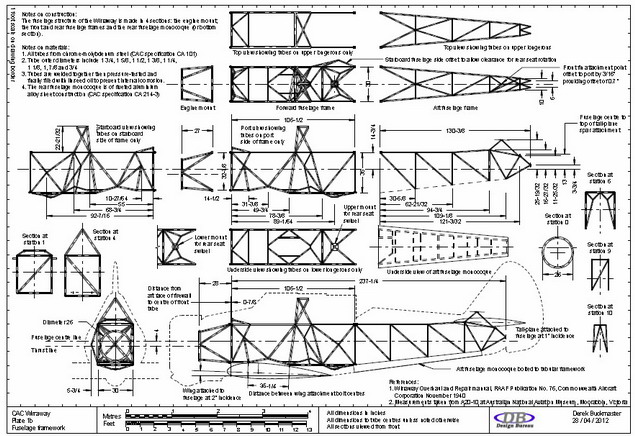 |
This drawing shows the geometry and dimensions of the Wirraway's welded chrome-molybdenum steel tube fuselage framework.
Click on the thumbnail to open a PDF
file formatted for printing on A4 paper (approximately 37 KB in
size).
|
Plate 2a. Wirraway wing station diagram |
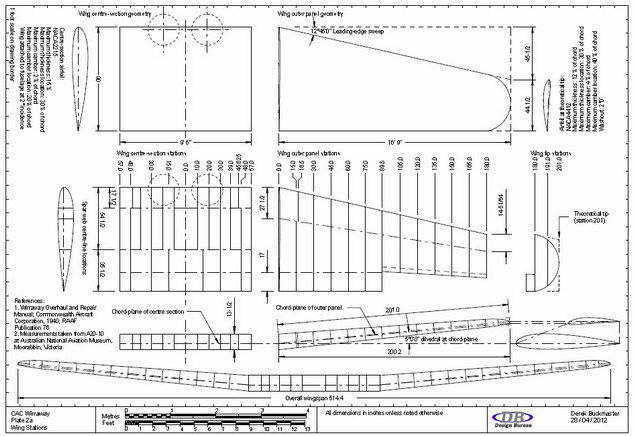 |
This drawing shows the geometry of the Wirraway wing
structure, including rib stations and airfoil sections.
Click on the thumbnail to open a PDF file formatted for
printing on A4 paper (approximately 17 KB in size). |
Plate 4a. CA-1 Wirraway side elevations |
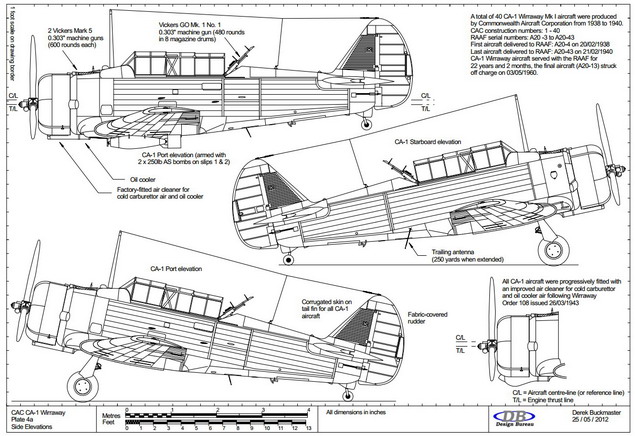 |
This drawing shows side elevations of the CA-1
Wirraway, showing the differences between the port and
starboard side of the aircraft.
Click on the thumbnail to open a PDF file formatted for
printing on A4 paper (approximately 17 KB in size). |
Plate 4b. CA-1 Wirraway plan view |
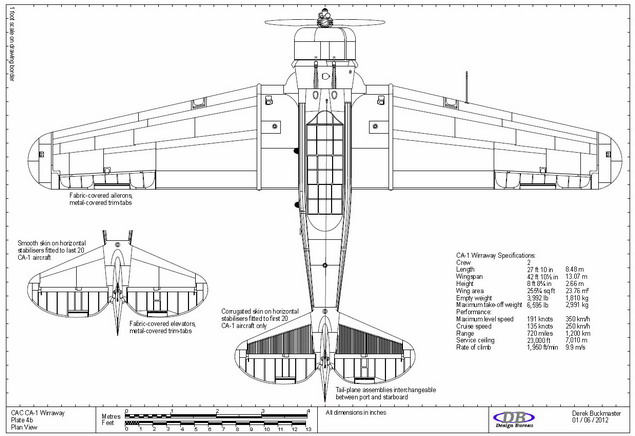 |
This drawing shows a plan view of the CA-1
Wirraway.
Click on the thumbnail to open a PDF file formatted for
printing on A4 paper (approximately 17 KB in size). |
Plate 4c. CA-1 Wirraway underside view |
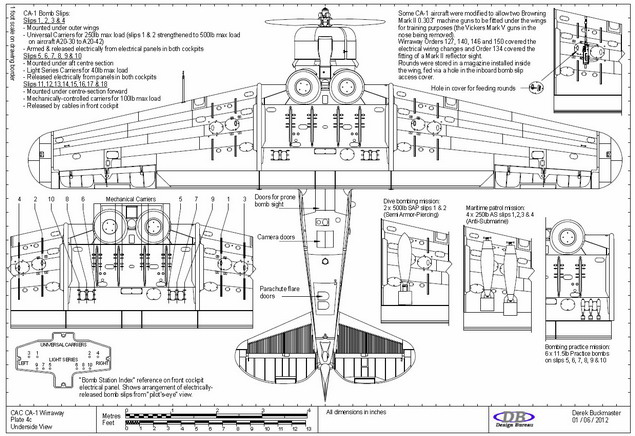 |
This drawing shows the underside view of the CA-1
Wirraway, including details of all the under-wing
armament which the Wirraway could carry.
Click on the thumbnail to open a PDF file formatted for
printing on A4 paper (approximately 17 KB in size). |
|
Plate 4d. CA-1 Wirraway front and rear views
|
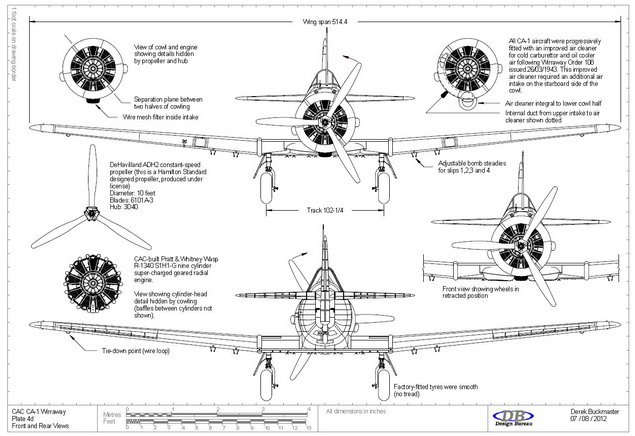 |
This drawing shows front and rear views of the CA-1
Wirraway, including details of the Pratt & Whitney
R-1340 Wasp engine.
Click on the thumbnail to open a PDF file formatted for
printing on A4 paper (approximately 17 KB in size).
|
Other drawings:
In my research for the drawings of the Wirraway shown above, I
have also collected a range of scale drawings created by other
draftsmen. The list below provides some details and comments about
these drawings (the drawings are listed by publication date, with
the earliest at the top).

|
Drawing by: Chuck Graham Date published: 1966
Source: IPMS Newsletter
Comments: This drawing shows details for a Wirraway Mk
II (produced under contract CA-5), in the markings of A20-103 (the aircraft now held at the Australian War Memorial collection).
This drawing was primarily intended to display the
colours and markings of A20-103, but when checked against aircraft measurements, several
dimensional inaccuracies
are readily apparent:
- Most noticeably, the engine cowl is drawn too long by 10.5"
- The wing chord is drawn 2" too long and the wing is
shown 5" too far forward
- The wing is drawn around 3.5" lower than it's actual location
- In the plan view the fairing between the wing and fuselage is
shown becoming wider in a curve towards the trailing edge. The actual fairing follows a straight line parallel to the centre of the aircraft along the top skin of
the wing centre section. The curved front section of this fairing is also drawn incorrectly where it meets the wheel housing.
- In the plan view the walk-ways on the wing centre-section are shown as panel lines, but this is incorrect.
|
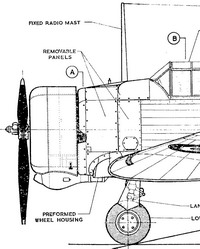
|
Drawing by: F. Pawlowicz Date published: December 1973
Source: Aeromodeller magazine
Comments: This drawing shows details for the CA-1 Wirraway Mk
I, in the markings of A20-10 (the aircraft now held at the Australian National Aviation Museum in Moorabbin). However
the drawing shows A20-10 following an upgrade to the late-style oil cooler and carburettor air intake below the cowl
(which became standard on the Mk III), so the drawing
does not represent an "as-built" CA-1. The
drawing was originally drafted at 1:24 scale (copies can still be purchased from Model Activity Press) and reproduced in the magazine at 1:48 scale.
When checked against aircraft measurements, several inaccuracies appear on this drawing:
- The tail-plane is drawn about 4" lower than it's actual location
- The wing is drawn around 3" lower than it's actual location
- The canopy rail is drawn around 3" lower than it's actual location
- The angle of the windscreen is too "raked", at
50° from vertical, wheras it should actually be
44.7° from vertical.
- The plan-view shows the fuselage bulging outwards between stations 27 and 106, but in reality the fuselage width is constant between these stations
- The antenna mast is drawn 8" too far forward
- The fairing between the wing and fuselage is
shown becoming wider in a curve towards the trailing edge.
The actual fairing follows a straight line parallel
to the centre of the aircraft along the top skin of
the wing centre section. The curved front section of
this fairing is also drawn incorrectly where it
meets the wheel housing.
- The walk-ways on the wing centre-section are
shown as panel lines, but this is incorrect.
- The propeller is listed as a "3 bladed
controllable speed metal propeller" but the
propeller is in fact "controllable pitch" for
constant speed operation.
- The configuration of bombs indicated in the
scrap-view is incorrect. The larger bombs (500lb
Semi Armour Piercing bombs) could only be mounted on
the inner universal carriers on the outer wing
panels (wheras they are shown mounted on the outer
carrier positions).
|
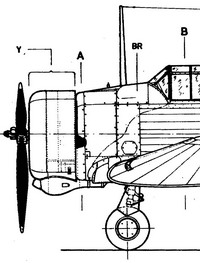 |
Drawing by: Zbigniew Luranc Date published: 1987
Source: Unknown
Comments: This drawing also shows the aircraft A20-10 following its cowling changes but lists this as a CA-1, which is misleading. The drawings were published in the magazine at 1:50 scale.
When checked against aircraft measurements, several inaccuracies
can be seen on this drawing:
- The tail-plane is drawn about 4" lower than it's actual location
- The wing is drawn around 3" lower than it's actual location
- The canopy rail is drawn around 3" lower than it's actual location
- The plan-view shows the fuselage bulging outwards between stations 27 and 106, but in reality the fuselage width is constant between these stations
- The antenna mast is drawn 8" too far forward
- The configuration of bombs is incorrect. The larger bombs (227
kg / 500 lb
Semi Armour Piercing bombs) could only be mounted on
the inner universal carriers on the outer wing
panels (wheras they are shown mounted on the outer
carrier positions)
|
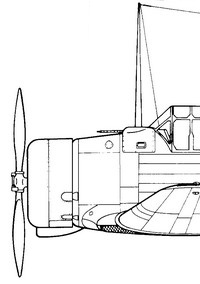 |
Drawing by: Perry Manley Date published: 1989
Source: T-6 Texan In Action by Larry Davis;
Squadron/Signal Publications, Carrollton Texas, 1989
Comments: A port elevation is included in this book
accompanying the chapter on the Wirraway and Boomerang.
When checked against aircraft measurements, several inaccuracies
are obvious on this drawing:
- The tail-plane is drawn about 4" lower than it's actual location
- The wing is drawn around 3" lower than it's actual location,
and the outer wing trailing edge is swept forward
while the Wirraway trailing edge has no sweep
- The canopy rail is drawn around 3" lower than it's actual location
- The antenna mast is too tall
- The engine cowl is drawn around 2" too far
forward, and the air intake is not the correct shape
- The drawing appears to show a 2-bladed propellor,
the diameter of which is too small
|
 |
Drawing by: Alex Pedashenko Date published: 1991
Source: Wirraway, Boomerang and CA-15 In Australian Service by Stewart Wilson, Sydney, 1991
Comments: A 3-view drawing appears in Stewart Wilson's book, but no draftsman is noted
on the drawing. The drawing features the "signature"
style of Alex Pedashenko (particularly the tufts of
grass on the ground-planes), and Stewart indicated that
he had received several drawings from Alex, hence it
makes sense that Alex was the draftsman. The drawing is listed as depicting the CA-3 and CA-9 aircraft (Mk II).
When checked against aircraft measurements, several inaccuracies appear on this drawing:
- The tail-plane is drawn about 3" lower than it's actual location
- The thrust-line is drawn around 4" higher than it's actual location - this results in the entire cowling being around 4" higher than it should be
- The plan-view shows the fuselage bulging outwards between stations 27 and 106, but in reality the fuselage width is constant between these stations
- The antenna mast is drawn 8" too far forward
|
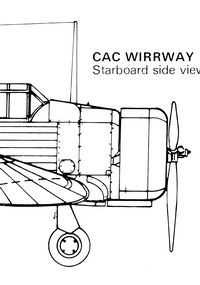 |
Drawing by: Colin Owers Date published: 1992
Source: Aviation News magazine, September-October 1992
Comments: This drawing shows details for several different versions of the Wirraway, however the views are not labelled. The drawings were published in the magazine at 1:72 scale.
The same drawings were published in Air Enthusiast 50,
alongside Owers' article about the Wirraway.
When checked against aircraft measurements, several inaccuracies appear on this drawing (many of which are the same as for the Pawlowicz drawing, leading to the conclusion that these drawings may have been traced from the Pawlowicz drawing):
- The tail-plane is drawn about 4" lower than it's actual location
- The wing is drawn around 3" higher than it's actual location
- The canopy rail is drawn around 4" lower than it's actual location
- The plan-view shows the fuselage bulging outwards between stations 27 and 106, but in reality the fuselage width is constant between these stations
- Several features are shown on the starboard side of the fuselage which are not actually there (the fuselage is not symmetrical)
- The underside view of the centre section and rear fuselage is not accurate
- The antenna mast is drawn 8" too far forward
|
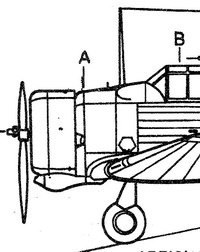 |
Drawing by: Joe Vella Date published: 1995
Source: Air Enthusiast magazine No. 61 Jan-Feb 1996
Comments: A small 3-view drawing by Joe Vella appeared alongside his article about the aircraft of CAC. The drawing depicts the CA-16 aircraft (Mk III) and shows the differences to other versions.
When checked against aircraft measurements, several inaccuracies appear on this drawing:
- The tail-plane is drawn about 3" lower than it's actual location
- The wing is drawn around 3" lower than it's actual location
- The canopy rail is drawn around 3" lower than
it's actual location
- The antenna mast is drawn 8" too far forward
|
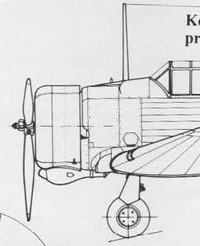 |
Drawing by: Unknown Date published: 1997
Source: CAC Boomerang CAC Wirraway by Andre Zbigniewski and Jacek Nowicki; Wydawnictwo Militaria, Warsaw, 1997 (published in Polish)
Comments: This drawing (perhaps drafted by Zbigniew
Luranc, or based on his drawing) shows the CA-1 ribbed
fin skin, but the later style carburetor and oil cooler
air intake below the cowl on the same profile, which is
misleading. The drawing does however correctly show the different access
panels and covers on the port fuselage side compared to
the starboard side.
When checked against aircraft measurements, several inaccuracies appear on this drawing:
- The engine, cowl and propeller have been drawn
4" above their correct location; it appears the
draftsman has laid the thrust-line over the fuselage
centre-line (or reference line) when in fact the
thrust-line is 4" below the fuselage centre-line
- The plan-view shows the fuselage bulging outwards between stations 27 and 106,
but the actual fuselage width is constant between these stations
- The antenna mast is drawn 8" too far forward
- The configuration of bombs is incorrect. The larger bombs (227
kg / 500 lb
Semi Armour Piercing bombs) could only be mounted on
the inner universal carriers on the outer wing
panels (wheras they are shown mounted on the outer
carrier positions)
- The instument panel layout shown on the drawing
is for the CAC Boomerang, not the Wirraway
|
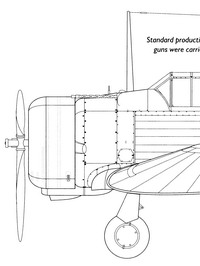 |
Drawing by: Richard J. Caruana Date published: November 2003
Source: Scale Aviation Modeller International magazine, Volume 9 Issue 11 November 2003
Comments: This drawing also shows details for several different versions of the Wirraway (Mk I, Mk II and Mk III) but again the views are not labelled. The drawings were published in the magazine at 1:48 scale.
When checked against aircraft measurements, several inaccuracies appear on this drawing:
- The tail-plane is drawn about 4" lower than it's actual location
- The wing is drawn about 2" lower than it's actual location
- The canopy rail is drawn around 3" lower than it's actual location
- The plan-view shows the fuselage bulging outwards between stations 27 and 106, but in reality the fuselage width is constant between these stations
- Several features are shown on the starboard side of the fuselage which are not actually there (the fuselage is not symmetrical)
- The underside view is not accurate around the
tail wheel, rear fuselage and engine oil cooler
- The antenna mast is drawn 4" too far forward
|
|


![]() If
you download these drawings, you agree to use them under the
Creative Commons Attribution Share-Alike 3.0 Unported License.
If
you download these drawings, you agree to use them under the
Creative Commons Attribution Share-Alike 3.0 Unported License.














